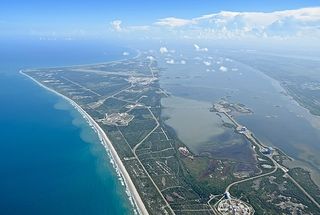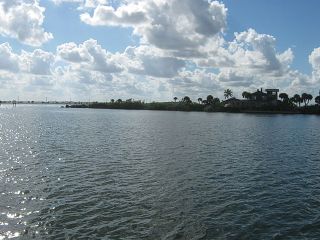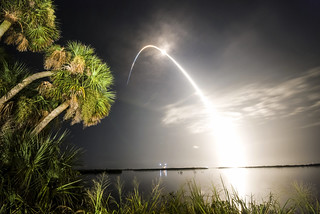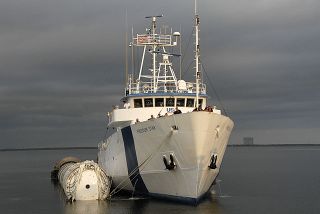Banana River: Difference between revisions
mNo edit summary |
mNo edit summary |
||
| Line 55: | Line 55: | ||
<br/>GIS: 28.458480,-80.624358</span> | <br/>GIS: 28.458480,-80.624358</span> | ||
<div class="mw-collapsible mw-collapsed" style="width:330px; overflow:auto;"> | |||
<div class="irlcollapsetitle">Banana River Tributaries</div> | |||
<div class="mw-collapsible-content"> | |||
<div class="irlcollapsetext">Tributaries are listed from North to South.</div> | |||
<div>{{#section:Water Body List|bananariverwater}}</div> | |||
</div></div> | |||
Banana Creek connects Banana River lagoon to the Indian River lagoon south of Max Brewer Bridge (SR404) in Titusville, Florida. A short distance south, Banana Creek enters Kennedy Space Center (KSC) property and dead ends at the "Crawlerway" causeway. | Banana Creek connects Banana River lagoon to the Indian River lagoon south of Max Brewer Bridge (SR404) in Titusville, Florida. A short distance south, Banana Creek enters Kennedy Space Center (KSC) property and dead ends at the "Crawlerway" causeway. | ||
| Line 65: | Line 71: | ||
Banana River ends at Dragon's Point, the southern tip of Merritt Island, where it joins the [[Indian River]] lagoon at Indian Harbour Beach. | Banana River ends at Dragon's Point, the southern tip of Merritt Island, where it joins the [[Indian River]] lagoon at Indian Harbour Beach. | ||
</div> | |||
<div class="irlcontentmiddle"> | <div class="irlcontentmiddle"> | ||
==Banana River Aquatic Preserve== | ==Banana River Aquatic Preserve== | ||
Florida Department of Environmental Protection's (DEP) [[Banana River Aquatic Preserve]] begins at State Road 528 (Bennett Causeway), extends almost to the southern tip of Merritt Island, and includes Newfound Harbor and Sykes Creek as far north as Hall Road. The FDEP's Banana River Aquatic Preserve is accessible from the east by U.S. Highway A1A and from the west by State Road 3. | Florida Department of Environmental Protection's (DEP) [[Unit:Banana River Aquatic Preserve]] begins at State Road 528 (Bennett Causeway), extends almost to the southern tip of Merritt Island, and includes Newfound Harbor and Sykes Creek as far north as Hall Road. The FDEP's Banana River Aquatic Preserve is accessible from the east by U.S. Highway A1A and from the west by State Road 3. | ||
The DEP's 2016 Indian River Lagoon Aquatic Preserves System Management Plan outlines the conservation objectives and activities needed in the Banana River Aquatic Preserve.<ref name="BRLMAP2016 /> The Banana River Lagoon Basin Management Action Plan (BMAP) is currently undergoing review and revision for a 2020 publication.<ref name="DEPBRLBMAP2020" /> | The DEP's 2016 Indian River Lagoon Aquatic Preserves System Management Plan outlines the conservation objectives and activities needed in the Banana River Aquatic Preserve.<ref name="BRLMAP2016 /> The Banana River Lagoon Basin Management Action Plan (BMAP) is currently undergoing review and revision for a 2020 publication.<ref name="DEPBRLBMAP2020" /> | ||
| Line 81: | Line 81: | ||
<span style="font-size:0.9em">See Also: [[Banana River Water Quality]]</span> | <span style="font-size:0.9em">See Also: [[Banana River Water Quality]]</span> | ||
[[File:Port-Canaveral-Super-Bloom.jpg|320px|thumb|right|2016 Banana River Superbloom]] | [[File:Port-Canaveral-Super-Bloom.jpg|320px|thumb|right|2016 Banana River Superbloom]] | ||
Like the rest of the IRL estuary, the Banana River lagoon suffers from nutrient pollution due to human impact. Stormwater runoff, faulty sewer systems, and septic tanks, over-fertilized lawns, and excessive development over wetland areas have greatly increased the residual levels of nitrogen and phosphorus in the water. | Like the rest of the IRL estuary, the Banana River lagoon suffers from [[Nutrient Pollution|nutrient pollution]] due to human impact. Stormwater runoff, faulty sewer systems, and septic tanks, over-fertilized lawns, and excessive development over wetland areas have greatly increased the residual levels of nitrogen and phosphorus in the water. | ||
Algae thrive on the excess nutrients, grows rapidly until it clouds the water, which blocks the sunlight and kills the seagrass beds. The blooming algae also cause a lack of oxygen in the water which in turn kills the marine animals. | Algae thrive on the excess nutrients, grows rapidly until it clouds the water, which blocks the sunlight and kills the seagrass beds. The blooming algae also cause a lack of oxygen in the water which in turn kills the marine animals. | ||
| Line 116: | Line 116: | ||
* [[:Category:Banana River Bridges|Banana River Bridges]] | * [[:Category:Banana River Bridges|Banana River Bridges]] | ||
* [[Banana River Facts]] | * [[Banana River Facts]] | ||
* [[Unit:Banana River Aquatic Preserve]] | |||
* [[Unit:Ulumay Sanctuary]] | |||
* [[Canaveral Lock]] | |||
* [[Canaveral Barge Canal]] | |||
==Web Links== | ==Web Links== | ||
* [https://fdep.maps.arcgis.com/apps/MapSeries/index.html?appid=3113f204a7814a228f0b052262562d01 DEP - Basin Management Plan Story Map] | |||
* [https://floridadep.gov/rcp/aquatic-preserve/locations/banana-river-aquatic-preserve Banana River Aquatic Preserve] | |||
* [https://fdep.maps.arcgis.com/apps/MapSeries/index.html?appid=3113f204a7814a228f0b052262562d01 | |||
* [https://www.waterqualitydata.us/provider/STORET/21FLCEN_WQX/21FLCEN_WQX-27010602/ Banana River Water Quality Map] | * [https://www.waterqualitydata.us/provider/STORET/21FLCEN_WQX/21FLCEN_WQX-27010602/ Banana River Water Quality Map] | ||
* [https://www.fws.gov/refuge/Merritt_Island/Fishing.html.aspx FWS - Banana River No Motor Zone Fishing] | |||
* [https://www.spanishflytv.com/article/urban-nature-banana-river-florida/ SpanishFlyTV - Urban Nature Banana River] | |||
==References== | ==References== | ||
Revision as of 10:45, January 8, 2021
Banana River is a 31 mile long, 30,000 acre brackish water lagoon that lies between Cape Canaveral and Merritt Island in Brevard County, Florida.
Banana River lagoon is bounded by Merritt Island on the western shore and the beach barrier island on the eastern shore.
The lagoon's northern shore lies within Kennedy Space Center (KSC) and the southern merges with the Indian River at Dragon's Point in Indian Harbour Beach.
Patrick Space Force Base lies along the eastern shore between Cocoa Beach and Satellite Beach.
Northern Banana River Lagoon is jointly administered by KSC and the U.S. Fish and Wildlife Service (FWS) as part of the Merritt Island National Wildlife Refuge. FWS maintains a No-Motor Zone on the lagoon between the KSC property line and the Beachline Expressway (SR528).[1] There is no public access allowed north of the KSC property line.
With an average 4ft depth, the Banana River Lagoon's shallow ecosystem includes numerous salt marshes, mangrove swamps, seagrass beds, oyster bars, mudflats, and spoil islands, that provide habitat for many animal and plant species.
The Banana River is an important spring habitat (300-500 individuals/survey day)[2] for the West Indian manatee, with many living in the lagoon year-round.
The Banana River Lagoon also supports the largest pelican rookery on the Atlantic Coast[2] and a significant population of Atlantic Bottlenose dolphin.
The Banana River lagoon is part of the EPA's Indian River Lagoon National Estuary Program and the Florida Department of Environmental Protection's Aquatic Preserve Program.
600 acres of Sykes Creek, a Banana River tributary, is preserved by Brevard's Environmentally Endangered Lands Program as the Ulumay Sanctuary.[3]
Commercial and recreational activities in the Banana River lagoon are estimated to generate more than $800 million annually for the local economy.
History
Historically, the Banana River lagoon was a continuous waterway that completely separated Merritt Island from Cape Canaveral.
In 1964, the Crawlerway was built at Kennedy Space Center, connecting Merritt Island to Cape Canaveral and dividing the Banana River into northern and southern lagoons.
Banana River Air Station
Construction of the Banana River Naval Air Station began in December 1939 and the station was commissioned on 1 October 1940.
The station supported seaplane patrol operations during World War II, a blimp squadron which conducted search and rescue along Florida's east coast, a PBM seaplane pilot training program, and an advanced navigation school.
In 1944 the station consisted of 391 officers, 2492 enlisted, and 587 civilians. The number of aircraft present on the base, including F6 Hellcats and O52U Kingfishers, reached a high of 228.
The station continued to operate as a Navy support base for two years after the war, but the installation was deactivated on 1 August 1947.[4]
Patrick Space Force Base
The Navy transferred the station to the Air Force on 1 September 1948 and it was renamed the Joint Long Range Proving Ground (JLRPG). On 1 August 1950, it was renamed Patrick Air Force Base in honor of Major General Mason Patrick.
Patrick Air Force Base is now the headquarters of the 45th Space Wing, the parent organization responsible for operations at Cape Canaveral Space Force Station.[4] On December 9, 2020 Patrick Air Force Base was renamed Patrick Space Force Base.
Water Body
See Also: Banana River Water Body
Location: 28°27'30.5"N, 80°37'27.7"W
GIS: 28.458480,-80.624358
Brevard
- Banana Creek
- Canaveral Lock
- Canaveral Barge Canal
- Sykes Creek
- Grand Canal
- Indian River
Banana Creek connects Banana River lagoon to the Indian River lagoon south of Max Brewer Bridge (SR404) in Titusville, Florida. A short distance south, Banana Creek enters Kennedy Space Center (KSC) property and dead ends at the "Crawlerway" causeway.
South of the Crawlerway, Banana River ranges through Kennedy Space Center and Cape Canaveral Space Force Station property to the Beachline Expressway (SR528) causeway.
At Port Canaveral, the lagoon connects to the Atlantic Ocean via Canaveral Locks and to the Indian River via Canaveral Barge Canal.
Sykes Creek, in central Merritt Island, connects to the Banana River south of SR520 in Cocoa Beach.
Banana River ends at Dragon's Point, the southern tip of Merritt Island, where it joins the Indian River lagoon at Indian Harbour Beach.
Banana River Aquatic Preserve
Florida Department of Environmental Protection's (DEP) Unit:Banana River Aquatic Preserve begins at State Road 528 (Bennett Causeway), extends almost to the southern tip of Merritt Island, and includes Newfound Harbor and Sykes Creek as far north as Hall Road. The FDEP's Banana River Aquatic Preserve is accessible from the east by U.S. Highway A1A and from the west by State Road 3.
The DEP's 2016 Indian River Lagoon Aquatic Preserves System Management Plan outlines the conservation objectives and activities needed in the Banana River Aquatic Preserve.[5] The Banana River Lagoon Basin Management Action Plan (BMAP) is currently undergoing review and revision for a 2020 publication.[6]
Banana River Lagoon Health
See Also: Banana River Water Quality
Like the rest of the IRL estuary, the Banana River lagoon suffers from nutrient pollution due to human impact. Stormwater runoff, faulty sewer systems, and septic tanks, over-fertilized lawns, and excessive development over wetland areas have greatly increased the residual levels of nitrogen and phosphorus in the water.
Algae thrive on the excess nutrients, grows rapidly until it clouds the water, which blocks the sunlight and kills the seagrass beds. The blooming algae also cause a lack of oxygen in the water which in turn kills the marine animals.
DEP's Banana River Lagoon Basin Management Action Plan[7] presents a long-term plan to restore seagrass habitats in the Indian River Lagoon Basin through the reduction of watershed loadings of total nitrogen and total phosphorus.
Excerpt from DEP's Banana River Lagoon Progress 2016 Review:
"In 2011, an algal super bloom occurred in the Banana River Lagoon (BRL) and North IRL, with a separate bloom affecting part of the Central IRL. A brown algal bloom affected much of the IRL during 2012. The full impact to seagrasses from these blooms will not be known for a number of years, but there are documented losses of seagrasses in the BRL linked to the blooms. Research is underway to understand the causes of these blooms; however, they appear to be due, in part, to legacy loads in the lagoon from past nutrient discharges. Removing the sources of nutrients from the lagoon’s watershed will help remediate the legacy load."[8]
A 2016 Harmful Algae Bloom (HAB) caused massive fish fills on the Banana River from Cape Canaveral to Indian Harbor Beach. Green algae blooms and dead marine life were common scenes along the river.
Restoration
The 2016 DEP Banana River Lagoon BMAP Progress Report list's many completed and ongoing projects, including stormwater retention systems, stormwater filters, sewer system repairs, and water quality monitoring.[8]
In January 2019 a $2.8 million stormwater and septic conversion project began in Merritt Island. It funded the installation of a new sewer main enabling the conversion of 23 commercial septic tanks and 60 residential septic tanks that were leeching effluent into the lagoon.
The 2019 project also funded the installation of stormwater pipelines that diverted stormwater runoff to retention filtering ponds instead of flowing directly to the river.[9]
Video
Select a video to play or visit the Indian River Lagoon Project YouTube Channel - Banana River Video Playlist.
Above Banana River at Kelly Park
Above Banana River at Thousand Islands
Above Banana River at Sunset
Banana River Fish Kill 2016
See Also
- Banana River Water Quality
- Banana River Organization
- Banana River Water Body
- Banana River Bridges
- Banana River Facts
- Unit:Banana River Aquatic Preserve
- Unit:Ulumay Sanctuary
- Canaveral Lock
- Canaveral Barge Canal
Web Links
- DEP - Basin Management Plan Story Map
- Banana River Aquatic Preserve
- Banana River Water Quality Map
- FWS - Banana River No Motor Zone Fishing
- SpanishFlyTV - Urban Nature Banana River
References
- ↑ FWS Merritt Island Refuge Fishing
- ↑ 2.0 2.1 Banana River Aquatic Preserve
- ↑ Ulumay Wildlife Sanctuary
- ↑ 4.0 4.1 Air Force & Space Museum Banana River Naval Air Station
- ↑ FDEP 2016 Indian River Lagoon Aquatic Preserves System Management Plan (PDF, 267pp)
- ↑ DEP - Banana River Lagoon BMAP 2020 Draft (DOCX 137pp 5.6MB)
- ↑ DEP Banana River Lagoon BMAP 2013 (PDF 90pp 1.49MB), retrieved 2021-01-08
- ↑ 8.0 8.1 DEP 2016 Banana River Progress Review
- ↑ SJRWMD 2019 BRL Stormwater and Septic to Sewer Project






